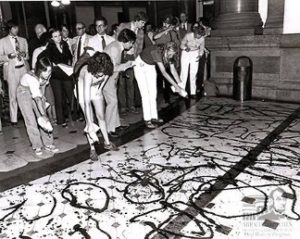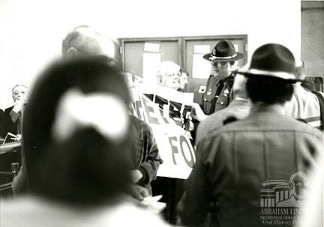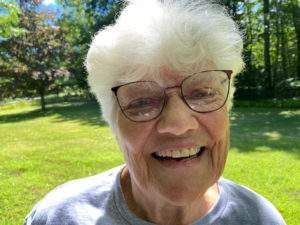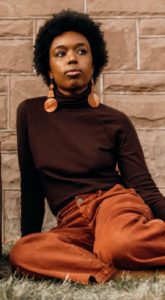
When the Equal Rights Amendment (ERA) went down to defeat, ERA activists showed their disapproval by writing the names of their opponents in pigs’ blood outside the governor’s office on June 25, 1982. Left to right are Ann Casey Elder, Sue Yarber, and Mary Lee Sargent. From the Mary Lee Sargent photos at the Abraham Lincoln Presidential Library and Museum site
On February 23, UCIMC Executive Director Miriam Larson hosted a virtual conversation with representatives of two generations of activists in Champaign-Urbana. Mary Lee Sargent, former director of Parkland College’s Women’s Studies Program (now residing in New Hampshire), was one of the early writers for the CU Lavender Prairie News. Current Urbana resident Jada Fulcher has revived the publication as The Lavender for today’s Queer community.
ML: I’m excited for this intergenerational conversation and meeting of the Lavenders! Mary Lee, you said you weren’t involved in starting the Lavender Prairie News?
MLS: No, but I was involved in the women’s community, which was really 99 percent lesbian, and I was intimately involved in all the activities it reported on. I wrote for it a lot.

Annie Liebowitz photo that appeared in Life Magazine in 1982 showing protesting women chaining themselves in the Illinois State Senate. From Sargent collection on Lincoln site
There were two activist groups in Urbana that I was very involved in: the Grassroots Group of Second Class Citizens, and Women Rising in Resistance. We started in the early ‘80s as direct action networks working for gay rights, lesbian rights, and feminist issues. In 2005 we put our papers in the Harvard-Radcliffe Schlesinger Library, the major library on the history of women in America.
The library contacted me again a year ago and said, “We’d like your personal papers as well.”
Because I taught history, I had a real awareness of keeping everything. I had wanted the U of I library to have a complete run of the Lavender Prairie News, and I put out a call to “give me all your back issues.” I got the full run and donated it to the U of I library [Microfilms available at the History, Philosophy and Newspaper Library]. I got enough copies to put another full run in the Schlesinger Library, and that curator said, “I am so excited to have this! We only had one issue!” It ran from 1977 until 1997 or 1998 and it was pretty much a monthly. So now Harvard and the U of I have the full run. How did you get your idea, Jada?

Archive copy of Lavender Prairie News at Urbana Free Library
[SargentPulcherImage1 about here. Caption: Archive copy of Lavender Prairie News at Urbana Free Library]
JF: The Urbana Free Library posts their archives on Instagram, and last June they posted a picture from the original Lavender Prairie News, and I thought, “Wow, I wish we had one of those right now.” And then I thought, why not?
I want The Lavender to be a space that announces events and creates community, but also tells the stories of queer people in town. For March I interviewed an environmental education programmer at the Urbana Park District. I come from a journalism background and I want it to be like a queer newspaper. We have a digital version that people can purchase, but we’re trying to focus on our print editions because people have a real interest in it.
MLS: It’s fantastic to do print because it will last. And make sure your Lavender gets archived. That’s one of my causes. I’m telling all my activist friends, “get your papers together!” because the Midwest needs to be represented! Harvard was eager to get our papers. They said, “We’re so underrepresented in the middle of the country for queer stuff or women’s things.”
JF: As a queer person who doesn’t live in a major city, I understand the feeling of not being represented. Most of us don’t live in LA or Chicago, or New York. I want media that represents what it’s like to be a queer person who lives in the rest of the country. And people need to know there’s other queer people around town. It could feel isolated if you come here and live in that world of queer academia, but just because the rest of this area is rural doesn’t mean queer people aren’t around and living and working.
MLS: Oh, yes, there’s lots of us! I didn’t grow up using “queer.” It’s not what I used for 60 years but I like it. I think it’s more all-encompassing than other terms.
ML: Jada, anti-trans legislation seems to have also motivated you in starting The Lavender.
JF: This country has become more hostile to gender-diverse people. That is talked about a lot in queer spaces. People from across the country come to Illinois, where, in a lot of places, it’s extraordinarily safe to be a queer person, but they still have to go home. They still have family. That thought is ever-present in watching legislation. Showing people that you can have a home here, you can feel safe here, was important to us.
MLS: And keeping it that way is our big challenge. The far-right forces that want to create The Handmaid’s Tale here are still a minority, but they’re a powerful minority.
JF: Our first edition came out last October. Except for January, when we took a break, we’ve put out an edition every month. We are doing print, online, the whole shebang. We’re working to make it accessible to people who have trouble with technology and to have it in the Urbana Free Library. It’s wild, people can go to the library and read a thing that I’ve worked on!
MLS: The number of things we need to be sensitive about is growing, and one is people who are not good with technology.
The Lavender Prairie News was produced in homes, and all the women who were involved were my close buddies. The collective was always small, it was four to eight women depending on what time period we’re talking about.

Mary Lee Sargent and Illinois Secretary of State Police, who provide security in the capitol building, during a protest for a house bill adding sexual orientation to the Illinois Human Rights Act in 1999. From Sargent collection on Lincoln site
I think our biggest challenge was burnout, more than conflicts over issues or politics. I would have heard if there were ideological conflicts. And there may have been breakups that I don’t remember because that was something. It was the period when a lot of us were going through our adolescence really, because we were newly coming out. We were dating and we didn’t really know how to date. So more personal things than ideological or creative ones created conflict.
ML: How did you keep from getting burned out?
MLS: I did take breaks and I kept aware of time commitments. If your calendar starts getting full, start cutting back! I’m still active. I’m not as much of an organizer now but I go to any demonstration that I can. I still do some speaking and a lot of writing, and I think that I’ve done okay because I didn’t ever burn out completely.
JF: I definitely have seen my calendar fill up.
MLS: That’s good too because that shows you’re being effective.
ML: You have a fellowship now, Jada?
JF: Yes, I live in a cooperative in Urbana, Harvest House, that’s part of a nonprofit called NASCO. They have a yearly Leadership Fellows program. I help people handle conflict and engage in democracy on a house level.
Mary Lee, I would love to talk to you in a more formal interview for our April Lavender edition. We’re doing a lesbian edition to honor the original Lavender Prairie News.
MLS: I’d be happy to talk! You definitely got one subscriber today!
———————————————————————————–
You can follow The Lavender on Instagram @thelavendernewsletter and/or contact them at thelavendernewsletter@gmail.com. Subscribe at patreon.com/thelavendernewsletter.
The Lavender will soon be available to the public in the Champaign County Historical Archives (located in the Urbana Free Library). The Lavender Prairie News (1982–87)
and several other LGBTQ+ newspapers are also available in the archives, including The Gay/Lesbian Prairie Press (1990–91), People Like Us (1986–87, 1990), and Prairie flame (2006–08).

Mary Lee Sargent lived in Champaign-Urbana from 1966 to 2003. She taught US History and US Women’s History at Parkland College and was active in the feminist, LGBT rights, civil rights, and anti-war movements. She now lives and works in New Hampshire.

Jada Fulcher (she/they) is a writer and journalist based in Urbana. Her work largely focuses on queerness, and especially the experiences of queer people of color. Follow them on Instagram and Twitter @jadafulcher.
434 total views, 1 views today